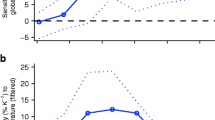Abstract
Using a stochastic approach with zero-dimensional energy-balance models, we consider the problem of periodic climate changes and the influence of integral feedbacks on climate oscillations. Based on the resulting linear integral–differential stochastic equation, we calculate the spectrum of fluctuations of average surface-air temperature and determine its statistical properties. We analyze the influence of proper cycles of inertial units and “slow” nonstationarity on the fluctuation spectrum.
Similar content being viewed by others
References
A. S. Monin and Yu. A. Shishkov, “Climate as a problem of physics,” Phys.-Usp. 43 (4), 381–406 (2000).
V. P. Dymnikov, V. N. Lykosov, and E. M. Volodin, “Modeling climate and its changes: Current problems,” Herald Russ. Acad. Sci. 82 (2), 111–119 (2012).
Climate Change: Observed Impacts on Planet Earth, Ed. by T. M. Letcher (Elsevier, Oxford, 2009).
B. A. Kagan, V. A. Ryabchenko, and A. S. Safrai, Response of the Ocean–Atmosphere System to External Forcing (Gidrometeoizdat, Leningrad, 1990) [in Russian].
A. S. Monin and D. M. Sonechkin, Climate Oscillations from Observational Data. The Triple Solar and Other Cycles (Nauka, Moscow, 2005) [in Russian].
A. V. Kislov, Climate in the Past, Present, and Future (Nauka/Interperiodika, Moscow, 2001) [in Russian].
K. E. Trenberth, Climate System Modeling (Cambridge University Press, Cambridge, 2010).
K. Hasselmann, “Stochastic climate model. Part 1: Theory,” Tellus 28 (6), 473–485 (1976).
P. F. Demchenko and A. V. Kislov, Stochastic Dynamics of Natural Objects. Brownian Motion and Geophysical Applications (GEOS, Moscow, 2010) [in Russian].
G. S. Golitsyn, Statistics and Dynamics of Natural Processes and Phenomena: Methods, Tools, and Results (URSS, Moscow, 2013) [in Russian].
Stochastic Climate Models (Progress in Probability), Ed. by P. S. Imkeller and J.-S. von Storch (Birkhäuser, Berlin, 2001).
D. Rapp, Ice Ages and Interglacials. Measurement, Interpretation and Models (Springer, Chichester, 2009).
V. Ya. Sergin and S. Ya. Sergin, The System Analysis of the Problem of Large Variations of Climate and the Earth’s Ice Ages (Gidrometeoizdat, Leningrad, 1978) [in Russian].
A. Ganopolski and S. Rahmstorf, “Abrupt glacial climate change due to stochastic resonance,” Phys. Rev. Lett. 88 (3), 038501 (2002).
V. Volterra, Theory of Functionals and of Integral and Integro–Differential Equations (Dover, New York, 1959;Nauka, Moscow, 1982).
R. E. Dickinson, “Convergence rate and stability of ocean–atmosphere coupling scheme with a zero dimensional climate model,” J. Atmos. Sci. 38 (10), 2112–2120 (1981).
R. E. Dickinson, “Land–surface processes and climate-surface albedos and energy balance,” Adv. Geophys. 25, 305–353 (1983).
U. Deker and F. Haake, “Fluctuation–Dissipation theorems for classical processes,” Phys. Rev. A 11, 2043–2056 (1975).
C. E. Leith, “Climate response and fluctuation dissipation,” J. Atmos. Sci. 32, 2022–2026 (1975).
A. Gritsun and G. Branstator, “Climate response using a three-dimensional operator based on the fluctuation–dissipation theorem,” J. Atmos. Sci. 64, 2558–2575 (2007).
A. J. Majda, B. Gershgorin, and Y. Yuan, “Low-frequency climate response and fluctuation–dissipation theorems: Theory and practice,” J. Atmos. Sci. 67, 1186–1201 (2010).
D. Archer, The Global Carbon Cycle (Princeton University Press, Princeton, 2010).
M. Ya. Verbitskii and D. V. Chalikov, Modeling the Glacier–Ocean–Atmosphere System (Gidrometeoizdat, Leningrad, 1986) [in Russian].
Author information
Authors and Affiliations
Corresponding author
Additional information
Original Russian Text © D.A. Petrov, 2017, published in Izvestiya Rossiiskoi Akademii Nauk, Fizika Atmosfery i Okeana, 2017, Vol. 53, No. 1, pp. 15–22.
Rights and permissions
About this article
Cite this article
Petrov, D.A. On the role of integral feedbacks in stochastic climate models. Izv. Atmos. Ocean. Phys. 53, 12–18 (2017). https://doi.org/10.1134/S0001433816060128
Received:
Accepted:
Published:
Issue Date:
DOI: https://doi.org/10.1134/S0001433816060128




